Reflections on the Role of Inquiry in the Life of the University
Spring Faculty Town Hall
ICC Auditorium
Georgetown University
Good afternoon. It’s a pleasure to be together at the start of another semester.
I look forward, today, to continuing a conversation about the challenges facing higher education at this moment, and the opportunities that these challenges present for us.
Several opportunities are being identified and explored by many of you in this room and your colleagues as part of our Designing the Future(s) of the University project and in other capacities. I am deeply grateful for your engagement – I know that when we come together as a community, we are best able to respond to the challenges that confront us.
In my remarks on November 20th[at the launch of the Designing the Future(s) project], I described the purpose of the university and identified three categories that provide the shape for our work—formation, inquiry and the common good. We engage in the work of formation of our students; we provide a context to support the inquiry—the scholarship and research of our faculty; and we contribute to the common good of our communities. I emphasized that these three elements are interlocking, mutually reinforcing and inextricably linked. It is a mistake to think these elements can be isolated from one another.
Today, I wish to offer some further reflections on Inquiry. Among the issues I wish to explore:
- Why is this important—what is the place, the role, the purpose of scholarship and research in the university?
- How does the practice of inquiry support the formation of our students and our commitment to the common good?
- What are the challenges that define this moment for the research mission of the American university?
- What are some of the ways in which we can respond?
While I know you might be thinking: isn’t the significance of this dimension of the university self-evident? Is it necessary to defend?
For reasons that I hope will become clearer, it is no longer a given that the framework that defines our mission today will continue in the face of the forces we confront today.
The ethos—the characteristic spirit of inquiry in the University
Inquiry that takes place in the university is unique from the nature of research that takes place in other types of settings. I wish to propose that there are five characteristics to the inquiry—the research and scholarship that take place in the university.
First, inquiry within the university takes many forms. The practice of inquiry differs across disciplines. Scholarship within the humanities is different from the social sciences and both are different from the natural and physical sciences. This pluralism is characteristic of the university. Not every university can sustain a context for research in every discipline, but every university makes choices that include a wide range of disciplines. There is a pluralism—a multiplicity—to the range of inquiry that takes place in the university.
The first characteristic of inquiry within the university is the openness to this range of forms.
Second, as I shared in my remarks in late-November, scholarship within the Academy takes place, in the words of Stefan Collini, “under the sign of limitlessness” (55). Collini offers this insight in a set of reflections on the enduring importance of John Henry Newman. Newman tried to differentiate between “useless” and “useful” knowledge in his lectures given at the founding of what is today University College Dublin. Newman was responding to the position of those who argued for an instrumental approach for the new university—one focused on preparation for employment. Newman suggested that a distinctive characteristic of a university is the idea that the work that takes place there is perhaps the only place where it can be unconstrained by applied or instrumental or “useful” expectations.
Collini defends this position and characterizes the nature of inquiry that we sustain here in the Academy—as “…the ungovernable play of the enquiring mind.” (8) By “ungovernable,” Collini means “there is no predicting where thought and analysis may lead when allowed to play freely….” (55). Again, Professor Collini:
“…it is a question of whether enquiry…is being undertaken under the sign of limitlessness—that is to say, not just, as with the development of all knowledge, subject to the testing of hypotheses or the revision of errors, but where the open-ended quest for understanding has primacy over any application or immediate outcome.” (55)
The second characteristic of inquiry within the university is the conviction that we should follow our inquiry wherever it may lead us.
Third, every August at the New Student Convocation we ask our students to take an Honor Pledge and in that moment we include the words: “…the disinterested pursuit of truth.” This word always catches me—what exactly is the sense of this word “disinterested?” I think it captures something like what Collini and Newman identify—and something more. The integrity of our work requires that we follow our inquiry wherever it may lead us and we are “disinterested” in the outcome. Not “uninterested.” We may even have a preference for how it turns out. But we can never let our preferences or predispositions cloud our judgment.
The third characteristic of inquiry within the university is this commitment to the “disinterested” pursuit of truth.
Fourth, perhaps the deepest conviction we bring to the work of inquiry concerns what we do with the product of our efforts: we share what we discover, reveal, construct and we place our insights into the public square for engagement and argument, discussion and conflict. There is a pattern to the nature of inquiry.
We engage in a search for truth through genuine dialogue and debate, through the presentation of evidence, from multiple perspectives. And then, discoveries—insights, scholarship—are shared among fellow scholars—within the faculty and beyond any particular university community. There is a predisposition, an expectation—we inquire to share.
Finally, there is a kind of inquiry that flows from these earlier characteristics. We are not constrained by the need for our work to be rewarded in the marketplace. Our ethos of inquiry enables us to pursue projects that are driven by our own sense of wonder, our sense of what is most meaningful, most important, regardless of conventional wisdom. There is a freedom to the focus and range of inquiry that takes place within the Academy. What we do with this freedom is worthy of our continuing reflection.
As I shared with you in November, universities provide an environment that seeks to sustain you in your inquiry. This work is characterized by uncertainty; it involves many false starts, re-tracings and repeated experiments, and makes great demands on those pursuing this route. Where the university helps is—beyond the critical support in providing general and specific resources and a community of good colleagues—is by offering security and protection.
Security entails engendering a sense of confidence that a scholarly project can be sustained over time. There is an enduring quality to universities; the pursuit of knowledge is not time-limited!
Protection, for its part, ensures that the defining dynamic of scholarship—the “ungovernable play of the inquiring mind”—can be given the limitless room for exploration. Faculty must be provided “space” for the “untrammelled quest for understanding.”
Inextricable links—Inquiry, Formation and the Common Good
An important point I tried to make the last time we were together was the way in which the three elements of the university were both inextricably linked and mutually reinforcing. I offered this comment in response to a position that holds that the elements of the university could be treated as if they were assets that could be acquired by a private equity firm, stripped, for the purpose of “value-creation.”
I reject this position. I think the university will only hold together if we protect the integration of these three elements. These “assets” cannot be stripped.
One of the most important insights coming out of the experience of American universities is the manner in which a commitment to inquiry reinforces the qualities that we cherish of liberal education. I know at different times in the histories of different universities, including our own, there has been tension between a focus on teaching and on inquiry. I believe out of these experiences we have found ways to engage this tension and find a balance between the responsibility of teaching and the practice of inquiry.
A liberal education seeks to provide students with capacities—for critical thinking—critique, for moral judgment, for communicating one’s thoughts and insights. A liberal education enables one to break down the barriers to interior freedom—so that one can achieve a sense of authenticity in one’s decisions and actions.
Once again, Newman:
“Hence it is that [an] education is called ‘Liberal.’ A habit of mind is formed which lasts through life, of which the attributes are freedom, equitableness, calmness, moderation, and wisdom…” (76)
And there is something else we hope a liberal education can proved: a capacity for wonder and how one can engage the work—the practice of inquiry so that one can embrace such wonder and build from that inspiration.
The most powerful way we can provide students with this capacity is to have them experience it with you—through you—as you model it in your own scholarship, your own inquiry.
Perhaps the most important skill we can develop in our students is the ability to inquire—to not allow themselves to be subject to the opinions of others, but to have the capabilities to explore the world, to come to their own conclusions, and shape their own understanding. In a world that is shaped by hidden forces—embedded in ideologies and algorithms, this capacity to inquire has never been more important.
And of course, the insights that result from the inquiry that takes place in the university adds to the stock of knowledge that informs our world. These insights are contributions to the common good.
Current Challenges and Opportunities
A crucial assumption of our work on the Future(s) is the belief that in the face of unprecedented challenges, we have extraordinary opportunities. I’d like to describe three dimensions to the current context for inquiry—for scholarship and research for universities in the United States:
- the current funding environment;
- our understanding of the nature of research; and
- the importance of articulating anew the research mission of the university.
Current Funding Environment
One of the ways we can assess the context for university research is to look at the funding environment. Since World War II, the crucial driver of the research missions of our universities has been Federal investment through the NIH, DOD and NSF.
Chart 1: Federal Investment in Research since 1976
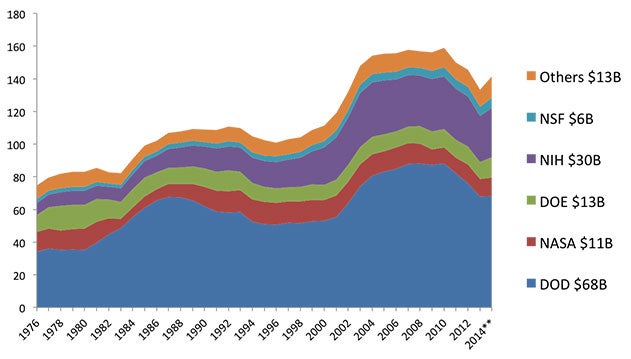
Chart 1, which draws on data from the NSF, will give you a sense of the Federal investment in research since 1976.
Chart 2: University R&D Spending by Funding Source ($ in billions)
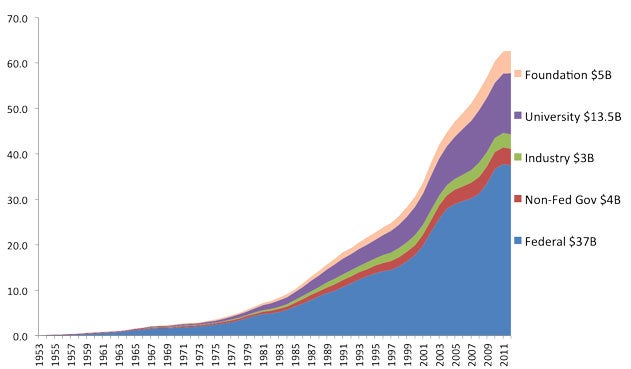
Chart 2, also drawing on data from the NSF, will give you another perspective on the place of the Federal government in supporting university research.
Chart 3: The role of the Federal government in supporting university research II
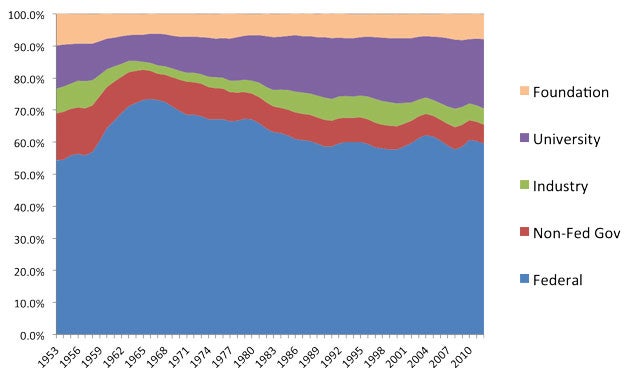
Chart 3, similarly drawn from NSF data, presents another way of showing the sources of support for university research.
I think this slide demonstrates a very powerful dynamic that has evolved over the past generation—the increasing responsibility of universities to fund research.
In 2012, the Federal government provided $37.4 billion in support of research to universities (Research & Development). The same year, universities spent $13.7 billion of their own resources (NSF). The ratio of university to federal spending is 36%. For most of the period following World War II that number was closer to 20%.
For Georgetown, the most significant support has come from the DOD and NIH for life science research. As a university, we conduct $180 million worth of research. Roughly three-quarters of our research takes place at our Medical Center.
This is the most challenging funding environment in our lifetime.
Chart 4: NIH Funding Trend ($ in billions)
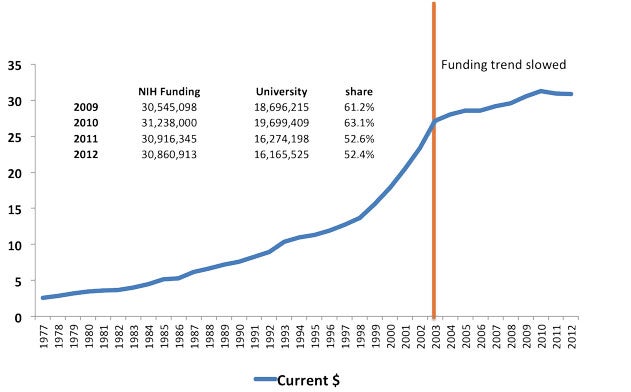
History of Congressional Appropriations
The “sequester” weakened an already deteriorating commitment of support for research in our Nation. As a result of sequestration, support for research at the National Institutes of Health has declined 5.5% (Rockey and Collins); overall Federal support for research has declined 3.3% (NSF). The amount of spending on research at our nation’s universities declined this past year for the first time since 1974 (NSF).
As a result of the decline in investment, at the NIH, only 1 in 6 proposals reviewed can be funded—the lowest rate in our lifetimes (NIH Fact sheet).
Chart 5: NIH Grant Application Success Rates
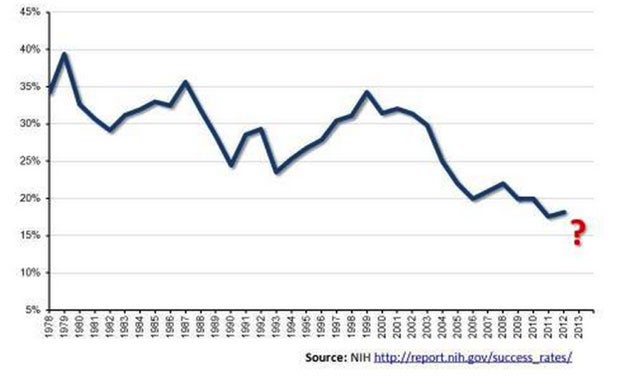
(Rockey and Collins)
We received very good news on January 17 when President Obama signed the 2014 federal budget into law. The new budget increases NIH funding by $1 billion (Committee on Appropriations). But even with this increase, funding for the NIH will still be below the 2012 level of funding. This increase restores $1 billion of the $1.55 billion cut as a result of the sequester (NIH Fact sheet).
This is occurring at time when other countries are significantly increasing their commitment to research. China has increased spending by 15% (Rockey and Collins). Between 1999 and 2009, the U.S. investment in research and development dropped from 38 to 31 percent of the world total; Asian nations’ share increased from 24 to 32 percent (“NIH Turning Discovery Into Health”).
Chart 6: Global Scientific R&D Spending
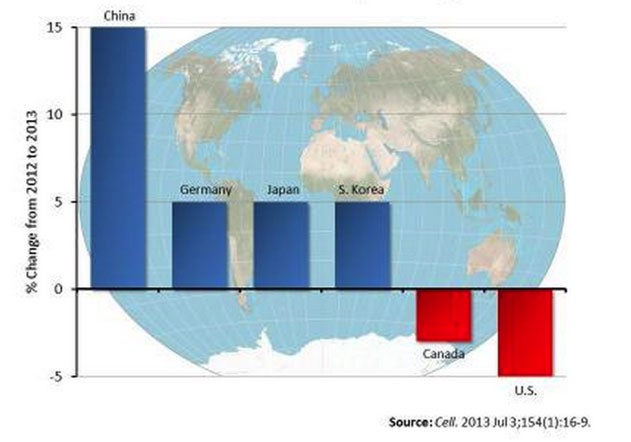
Rockey and Collins
The model that has shaped our nation’s research efforts for seventy-years is changing and we will have to adapt to these changes.
Our Understanding of the Nature of Research
In the American context, our understanding of the interplay between the Federal government and our universities was shaped by the experiences in World War II. The call to support the war effort mobilized the research in many universities and that experience shaped the findings of Vannevar Bush, whose report, Science: The Endless Frontier, provided the blueprint for federal investment in university research that has continued to this day.
Bush’s most enduring insight is the conception of a linear model of innovation:
Chart 7: The Linear Model
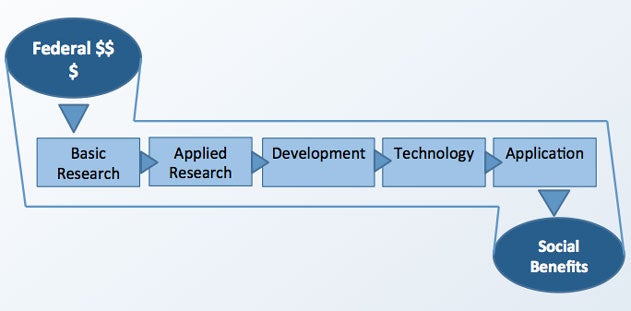
Mirowski 47
Universities are typically described as being focused on the left stage of the model—Basic research.
This model has proven surprisingly long-lived, though many have expressed dissatisfaction with it—that nothing is quite this simple. Writing nearly twenty-years ago, Donald Stokes, in his book Pasteur’s Quadrant, sought to provide a more dynamic understanding of the nature of research—one shaped by two elements, “considerations of use” and “quest for fundamental understanding”:
Chart 8: Quadrant Model of Scientific Research
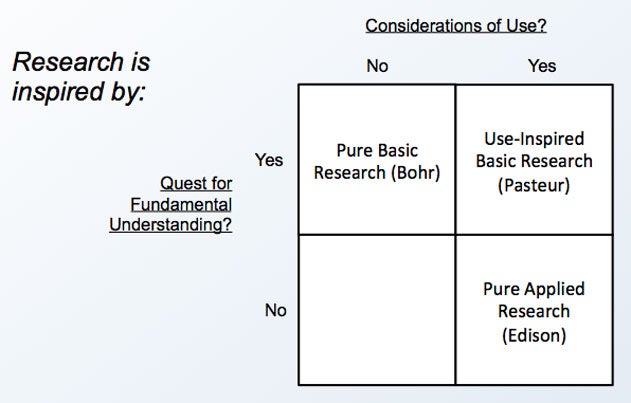
Stokes 73
But more important to understanding the nature of research and how it has been changing is to understand the role of market forces in challenging our understanding. We are more than a generation into a new way of thinking about the role of research within the university.
We could place the origin of this understanding with a piece of legislation passed in 1980, authored by Senators Robert Dole and Birch Bayh. Bayh-Dole permits those whose research is supported by federal grants to seek patents on their discoveries. We no longer pursued our research simply under the sign of limitlessness; we entered a new era for universities—an era of intellectual property.
These changes took place over time. It was not until 1993 more than a decade after the passage of Bayh-Dole that we joined AUTM—the Association of University Technology Managers. We have certainly had some incredible achievements in this new regime of IP, most notably the role of Ray Woosley and colleagues in the development of the anti-histamine, Allegra, and the extraordinary work of Richard Schlegel, in the development of the first-ever cancer vaccine, Gardasil.
But the IP regime since its inception has been dominated by just a small number of universities: “Only 37 universities have been able to reach the top 20 of licensing revenue any given year over the last decade” (Valdivia 6). Georgetown has not achieved top 20 standing in any year.
Today, we are experiencing a new focus—on “start-ups.” The unfolding emphasis on “start-ups” is influencing the self-understanding of the research missions of universities.
The Importance of Articulating the Research Mission of the University
I believe we need to respond to this emphasis. I believe the place to start is for us to define the kind of research we think we should be engaged and I believe the starting point is to re-examine the characteristics that are unique to the ethos of the university.
The university, by its nature, engages the work of its people in the “long haul”—of what we might call the “longue durée”: noting that knowledge is extended, generation by generation, but also celebrating what is valuable in the past integrated with what is surprising and novel—what is discovered.
The university, by its nature, brings together young people—the eager-for-knowledge, combined with the older who are versed in what exists—but, through their work of inquiry, are investigating what is surprising and novel. Our faculty conduct this work along with the students to whom they minister.
And the university, by its nature, brings together a diversity of perspectives—by disciplines, by interests, by backgrounds—the plurality of views is a strength that we should be rejoicing in.
If we do celebrate the ethos of the university and aim to make the elements of it even more strongly cohere, where are we potentially in danger? Do we find ourselves distracted by a logic—a market logic, that is not integral to a university? Are we becoming vulnerable to those who believe that are mission is not integral—does not have to have the elements of formation, inquiry, and common good as fundamental to what we are?
Looking specifically at inquiry, I’d ask: what kind of research should an institution characterized by the qualities of pluralism, limitless, disinterestedness, sharing, and a history of taking on certain kinds of projects—the characteristics of inquiry at a university: when challenged? How should we respond?
I argue that we should be looking at our strengths and build upon them.
I believe we should engage in inquiry that flourishes within the unique context of the university. The kinds of inquiry that is pursued must be animated by the imagination and creativity—the sense of wonder—that will sustain one through all of the demands that a commitment to inquiry requires. We provide a home to support these pursuits. I would like to identify four characteristics of the kind of inquiry that should be pursued in the university.
First, we should always recognize that some projects require a deep commitment of time—there is an enduring character—the implication of limitlessness: much of our work takes time and we should not gainsay that; “good” work takes time, and that is possible—and perhaps only possible—in the university. We celebrated our 225th anniversary last Thursday. We have been at this work for a long time! We provide a home for work that no one else does.
Of course, not everyone is animated by projects of a “longue durée.” This reflects our pluralism of interests. But a unique characteristic of the university is our capacity to sustain enduring work.
Second, some work has a deep sense of urgency—there are high-stakes—and the work that takes place here must recognize these most urgent and important challenges facing our world today: for example, climate change, religious and ethnic strife, environmental sustainability, nuclear proliferation, hunger. Our universities offer perhaps the best context for a sustained engagement with these challenges—they are long-term, entail “old” and “new” knowledge, demand multi-disciplinary thought—and can be animated by the fresh minds of students.
Not all inquiry is high stakes as my brief list suggests, just as not all research involves “longue durée“; my point is that it is perhaps only within the university that such work—short-and longer-term—can be done, and done within the same milieu—given that the context of the university allows it to flourish unimpeded.
Undeterred by local and regional political pressures, we can pursue projects that acknowledge our responsibilities for future generations. I will never forget a conversation I once had with Joel Meyerson, a distinguished colleague who runs the Forum for the Future of Higher Education. Joel is the father of two young sons and said to me: “I am trying to imagine my response to my grandchildren when they ask me about our generation’s response to climate change: What were you thinking, why didn’t you do more?” If any institutions in our world can ensure an attention to the most urgent and important issues, it is our universities.
At the same time, while no institutions in our world bring together so much diversity of talent and expertise across so many areas of knowledge, we must be alert to the thrust of those who attempt to limit our richness. To counter that, we should increase that diversity by fostering inter-disciplinary, trans-disciplinary, multi-disciplinary work in ways that would be impossible without our diversity of talent. We must acknowledge that we are not always able to work through the boundaries of our own disciplines. If we are going to make the contribution that only we are capable of making, we will need to address the blocks that limit such connecting.
Finally, again, we need to recognize the incomparable strength that derives from the presence of young people as we engage in the work of inquiry. Your work can inspire a sense of wonder that they can only experience by being in your presence. In turn, their energy, enthusiasm and idealism can encourage you. Universities are places pulsating with energy because of the presence of the young. No other context for inquiry is quite like this.
Let me stop there. In closing, what I hope I have provided is a deeper perspective into one of the three elements that characterize the university. There are distinctive qualities to the nature of inquiry; we are undergoing fundamental shifts in the way our nation supports research; and in such a context, I think it is important that we engaged in sustained reflection over the kind of inquiry we hope we can support.
Thank you for listening. I now open this up for questions and comments on these reflections or on any issues of the day.
Works Cited
- Britt, Ronda. “Higher Education R&D Expenditures Remain Flat in FY2012.” Info Brief – National Center for Science and Engineering Statistics. National Science Foundation. Nov. 2013. Web.
- Collini, Stefan. What are Universities For?. New York: Penguin, 2012. Print.
- “Fact sheet: Impact of Sequestration on the National Institutes of Health.” National Institutes of Health. 30 Jan. 2014. Web.
- Grueber, Martin and Tim Studt. “2012 Global R & D Funding Forecast: Stable Growth of U.S. R & D.” Research & Development. 30 Jan. 2014. Web.
- “History of Congressional Appropriations.” NIH — Office of Budget —Appropriations History by Institute/Center (1938 to Present). National Institutes of Health, n.d. Web. 30 Jan. 2014.
- Mirowski, Philip. “The “Economics of Science” as Repeat Offender.” Science-mart: Privatizing American Science. Cambridge, MA: Harvard UP, 2011. 47. Print.
- Newman, John Henry. The Idea of a University. Notre Dame, Indiana: University of Notre Dame Press, 1982. Print.
- “NIH Turning Discovery Into Health: Global Competitiveness – The Importance of U.S. Leadership in Science and Innovation For the Future of Our Economy and Our Health.” National Institutes of Health. Web.
- Rockey, Sally, and Francis Collins. “One Nation In Support of Biomedical Research.” NIH Extramural Nexus. NIH, 24 Sept. 2013. Web. 30 Jan. 2014.
- Stokes, Donald E. “Transforming the Paradigm.” Pasteur’s Quadrant: Basic Science and Technological Innovation. Washington, DC: Brookings Institution, 1997. 73. Print.
- “Summary: Fiscal Year 2014 Omnibus Appropriations Bill.” Committee on Appropriations. 13 Jan. 2014. Web.
- Valdivia, Walter D. “University Start-Ups: Critical for Improving Technology Transfer.” Center for Technology Innovation at Brookings. Washington, DC: Brookings Institution, Nov. 2013. Print.